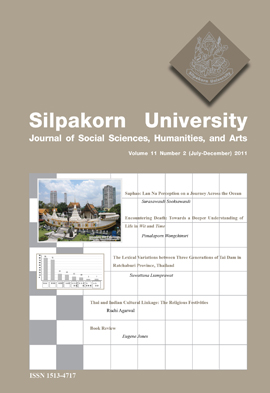Saphao: Lan Na Perception on a Journey Across the Ocean
Main Article Content
Abstract
Saphao is a Lan Na word equivalent to the Central Thai samphao referring to a Chinese style ocean-going merchant shipor junk. There are many archaeological traces such as terracotta seals, medals and stucco motifs found in many sites in Thailand depicting the connection with India, the Jambūdvīpa, and SriLanka. Some of those present the journeys by one-mast vessels and also brigs. Several folk jatakas composed by Lan Na monks, as scholars, during the 15th – 16th Centuries A.D. referred to ajourney made by samphao namely, Suwannasangaraja jātaka and Chanthakataka jātaka for example. Although the jātakasdid not give any detailed description of the samphao and the journeys made by them, several Buddhist documents of several sects in Lan Na contain records of the trips made for the purpose of perpetuating Buddhism from its origin in Sri Lanka via such transportation as the samphao.
The ‘crossing the great ocean’ conveys both the concrete and abstract meanings which include crossing over the samsāra or the process of life and death (birth, aging, sickness and death) transcending the Lokīya, the worldly and mundane, comforts to Lokutara, the supramundane or absence of such unpleasant conditions. Several objects of sacrifice dedicated to certain important chedis containing the Buddha relics in the Lan Natradition include saphao kham (golden junk) which is also partof the sacrifice in certain Lan Na rites. In some Lan Na folk rites practiced for the merit dedicated to a woman who died in giving birth to a child it is required to have a model of saphao to carry all kinds of fishing equipment. This is to assist the dead woman who died soaking in blood and amniotic fluid to ride on it and get released to be born again. Part of the merit dedicating phase accompanying the rite says that may the merits gained from this rite be like a crystal and golden ship taking the unfortunate person to the next life.This article aims to investigate the allusions to saphao in the various contexts of Lan Na society in the past, especially those related to Buddhist history, social history and its culture.
Downloads
Article Details
All rights reserved. Apart from citations for the purposes of research, private study, or criticism and review,no part of this publication may be reproduced, stored or transmitted in any other form without prior written permission by the publisher.
References
Damrong Rajanubhab, Prince. (1931) Record of the Journey Along the Ping River from Chiang Mai to Pak Nampho. Bangkok: Soponpipattanakorn.
________. (1956). Paññāsa Jātaka. Bangkok: Silapa Bannakan.
Hazra, Kanai Lal. (1982) History of Theravāda Bluddhism in South-East Asia. Calcutta: Munshiram Manoharlal Publishers Pvt. Ltd.Juan Kruaevittayayajarn. (2537) The way of life of the Mon. Bangkok: Sutthakarnpim.
Mayuree Veraprasert. (1984) Muang Boran. Vol. 10 No. 1 January-March.
Mendelson, Michael E. (1975) Sangha and State in Burma. London: Cornell University Press.
Miksic, John. (1990). Borobudur: Golden Tales of the Buddhas. Singapore: Craftprint Pte. Ltd.
Nandana Chutiwongs and Leidy, Denise Patry. (1994) Buddha of the Future: an Early Maitraeya from Thailand. U.S.A.: The University of Washington Press.
Niyada Sarikabhuti. (1980) Paññāsa Jātaka: Its Genesis and Significance to Thai Poetical Works. Thesis Submitted in Partial Fulfillment of the Requirements for the Degree of Doctor of Philosophy, Department of Thai, Graduate School, Chulalongkorn University.
Penth, Hans and Srilao Ketphrom. Unpublished. “ Payao inscription no. 1.5.1.1 Wat Rattanavarāram 2042/1499,” the Archive of Lan Na Inscriptions, Social Research Institute, Chiang Mai University.
________. unpublished. “Inscription no. 1.4.1.1 Wat Paruang inscription A.D.1485,” the Archive of Lan Na Inscriptions, Social Research Institute, Chiang Mai University.
________. unpublished. “Inscription no. 1.4.1.1 Wat Pa Ku Kae, A.D.1559,” the Archive of Lan Na Inscriptions, Social Research Institute, Chiang Mai University.
________. unpublished. “Inscription no. 1.5.1.1 Wat Kaoyot, A.D.1524,” the Archive of Lan Na Inscriptions, Social Research Institute, Chiang Mai University.
Pradit Sappachang. (1999) “Rue,” Encyclopedia of Thai Culture: the Northern. Vol. 11. Bangkok: the Siam Commerce Bank Thai Encyclopedia Foundation.
Prapatsorn Posrithong. Editor. (1999) Phrapathom Chedi National Museum. Bangkok: Fine Arts department.
Reid, Anthony. (1993) Southeast Asia in the Age of Commerce 1450-1680 Volume Two: Expansion and Crisis. Michigan: Edwards Brothers Inc.
Schlingloff, Dieter. (1976) “Kalyānakārin’s Adventures: The Identification of an Ajanta Painting,” Artibus Asiae . Vol. 38, 1.Skilling, Peter. 2008 “Narrative, art and ideology: Jatakas from India to Sukhothai,” Past Lives of the Buddha: Wat Si Chum, Art, Architecture and Inscriptions. Bangkok: Bangkok Printing Co., Ltd.
Sone Simatrang. (2526) The Structure of Lanna Mural Paintings. Vol. 2 Plates. Bangkok: Silpakorn University.
Sraswadee Aungsakun. (1996) Pravattisat Lan Na. Second Edition. Bangkok: Amarin Printing and Publishing Ltd.
Srawut Rupin. (2544) Study of Sapao in Lampang. Individual Study 1. Department of Thai Art. Faculty of Fine Arts. Chiang Mai University.
Srilao Ketphom. (2008) Interview on 15th September at the Social Research Institute, Chiang Mai University.
Sujit Wongtet. Editor. (1995) Inscriptional History of Phayao. Bangkok: Pikanet Printing Center Ltd.
Surasawasdi Sooksawasdi. (2000) “Records on the Journey by the Mae Ping River,” Muang Boran. Vol. 26 No. 3 July-September.
Surasawasdi Sooksawasdi and Penth, Hans. (2007) Buddhist Art in the Sihalabhikkhu Sect A.D. 1350-1550: Studies from Sihing Buddha Images and dated Buddha Images in Thailand. Chiang Mai: the Institute of Social Research, Chiang Mai University.
Udom Rungruangsi. (1999) “Suvannasangkhrachakuman Jataka,” Encyclopedia of Thai Culture: the Northern. Vol.13. Bangkok: the Siam Commerce Bank Thai Encyclopedia Foundation.
Wray, Elizabeth. et al. (1974) Ten Lives of the Buddha: Siam Temple Paintings and Jataka Tales. Second Edition. New York: John Weatherlill Inc.
Wyatt, David K. and Aroonrut Wichienkeeo. (1998) The Chiang Mai Chronicle. Second Edition. Chiang Mai: Silkworm Books.
Suphadradis Diskul, M. C. (1979) History of Southeast Asia to B.E. 2000. Bangkok: Ministry of Interior.


